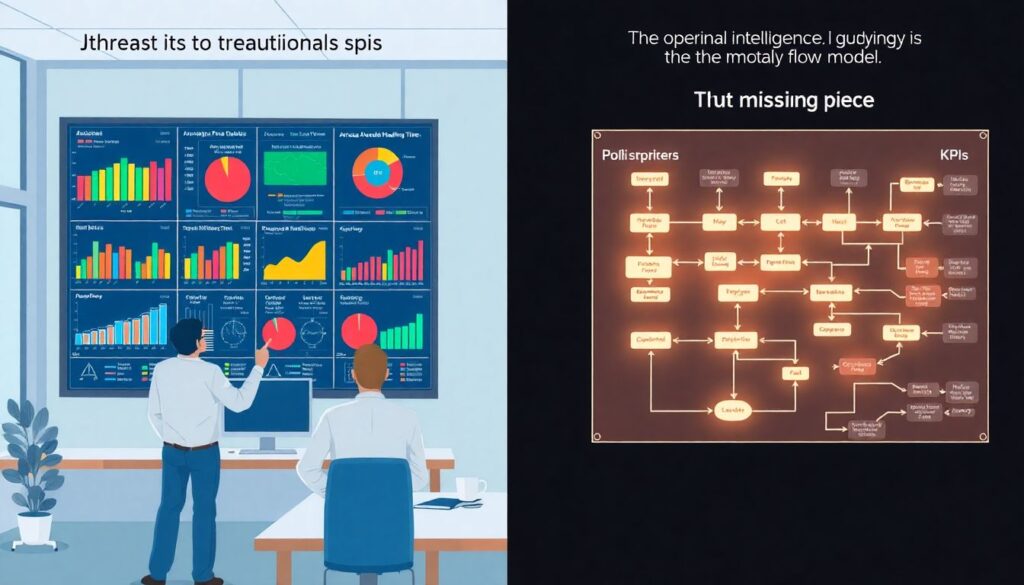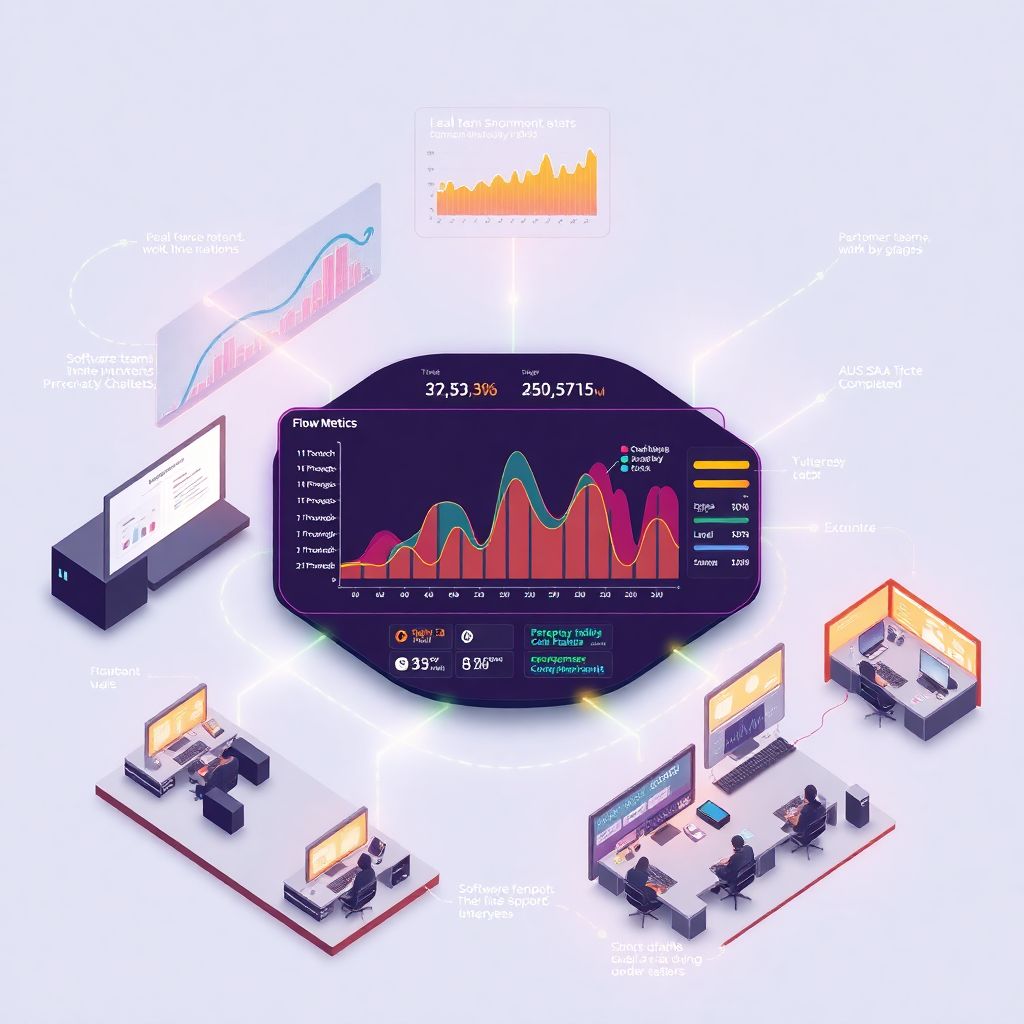Why OI Flow Metrics Matter Right Now
When people first hear “OI Flow Metrics,” it often sounds like yet another buzzword stack: operational intelligence, flow, metrics, dashboards… the usual suspects. But under the jargon there is a very practical idea: measure how value actually moves through your operations in real time, then use those insights to make better decisions faster. In other words, stop guessing why work gets stuck, and start instrumenting your processes the way engineers instrument production systems. That is the core shift from static reporting to operational intelligence.
Historical Background: From BI Reports to Real‑Time Flow
To understand OI Flow Metrics, it helps to rewind a bit. Traditional Business Intelligence grew up around static reports and data warehouses. You pulled data from transactional systems once a day or once a week, then analysts produced slide decks that nobody read after the steering committee. The focus was on historical aggregates, not on how the process was behaving right now. As digital operations became more complex and more interconnected, this lagging view stopped being enough.
Around the late 2000s and early 2010s, event streaming, log analytics and real‑time dashboards became mainstream. That is roughly when “operational intelligence” emerged: instead of just storing and summarizing data, systems started to process events as they happen. The idea was to observe the live state of orders, tickets, transactions or sensor streams and react immediately. OI Flow Metrics are a natural extension of this trend: they treat every operational process as a stream of flow units and measure latency, throughput, variability and blocking points in real time. Where classic BI asked “What was our average cycle time last quarter?”, OI asks “Where is flow breaking down in the last 15 minutes and who needs to know right now?”.
Core Concepts: What “Flow Metrics” Actually Measure

At the heart of OI Flow Metrics is the notion of a flow unit moving through a sequence of states. In software development it might be a user story; in customer service, a ticket; in logistics, a shipment; in finance, a transaction. For each unit you can track timestamps and transitions across states such as “Created”, “In Progress”, “Waiting”, “Completed”, and then derive the key metrics: lead time, cycle time, waiting time, work in progress, throughput and failure rate. The magic is not in any single metric but in how they interact and change over time when the system is under stress.
A mature operational intelligence analytics platform will model these processes as event streams, correlate events to specific flow units and stages, and compute aggregate metrics in real time. From there you can start asking more nuanced questions: how does flow differ per customer segment; which team or machine is a bottleneck; how does a deployment or policy change shift the distribution of waiting times. Essentially, OI Flow Metrics are the observability layer of your operations. Just as application performance monitoring reveals what your code is doing, flow metrics reveal what your business processes are doing minute by minute.
Basic Principles of OI Flow Metrics
The first principle is end‑to‑end visibility. Measuring only a single stage, like the “execution” step, tells you almost nothing about flow. You want to instrument the entire path from first touch to final completion, including all the handoffs and queues. That means mapping the process explicitly, aligning system events and human activities to that map, and making sure every state transition is logged with sufficient context. Without this, you end up optimizing local steps while the real delays live in invisible queues between teams or systems.
The second principle is time as a first‑class citizen. OI Flow Metrics are fundamentally temporal: you are concerned with when things start, how long they wait, and when they complete. This is why a simple workflow performance metrics dashboard that shows just counts per status is not enough. You need distributions of lead time, percentile latency, aging WIP, and time‑to‑breach for SLAs. When you treat time seriously, you can distinguish between a backlog that is healthy and one that is rotting quietly in the corner because items have been stuck for weeks. Time‑based metrics expose concealed risk, not just volume.
The third principle is feedback into decision‑making. Metrics that just sit in a dashboard are dead weight. OI Flow Metrics only pay off when they drive actions: rebalancing teams, changing prioritization rules, adjusting WIP limits, or triggering automated workflows. That is where process optimization tools for flow metrics become critical: they help you run controlled experiments, compare before‑and‑after behavior, and avoid cargo‑culting random “best practices”. Without explicit feedback loops, you are just decorating your wall with graphs instead of improving the system.
From Concept to Execution: Getting the Data Right
Turning OI Flow Metrics from theory into something useful usually starts with the data plumbing, and this is where many teams stumble. The main challenge is that operational data tends to be fragmented: some events live in your CRM, others in your ticketing system, others in custom line‑of‑business apps or spreadsheets. To build a coherent view of flow, you need consistent identifiers for flow units, aligned timestamps, and a minimal process model that can stitch everything together. Otherwise the analytics engine will compute impressive but misleading numbers.
This is the point where business process flow metrics software can help, but tools do not eliminate the need for clear definitions. You must decide what counts as “start” and “end”, which transitions matter, and how to handle reopens, cancellations or error states. Teams that skip these alignment conversations end up arguing over whether the dashboard is “wrong” rather than using it to improve outcomes. Good practice is to start with a single critical process, define stages coarsely, wire up event collection, and validate a small set of metrics with frontline staff before scaling to other processes or domains.
Examples of Implementation in Real Organizations
Consider a customer support organization drowning in tickets and complaints about response times. They adopt OI Flow Metrics by instrumenting their intake forms, triage queue, agent assignments and resolution events. Each ticket becomes a flow unit with events for “Received”, “First Response”, “On Hold”, “Escalated” and “Resolved”. Using a simple OI setup, they discover the real issue is not agent speed but a triage bottleneck between Level 1 and Level 2 teams; tickets sit unassigned for hours during shift changes. By changing handoff rules and monitoring the new flow in real time, they cut end‑to‑end lead time dramatically without hiring more staff.
In a manufacturing context, a plant uses OI Flow Metrics to observe how work orders move through machines and inspection stages. Sensors and MES events become the raw data. The operational intelligence analytics platform correlates these to specific work orders and computes live throughput and waiting time at each station. Management learns that one test bench is consistently creating a downstream pileup during peak hours. Instead of adding another production line, they adjust scheduling and preventive maintenance windows for that bench. The same approach works in digital product delivery: a SaaS team instruments code changes from commit to production and uses real‑time flow metrics to spot when a particular microservice or team becomes a chronic bottleneck after large feature drops.
Tooling: Dashboards, Alerts and Integrated Systems

Once the data layer is sorted out, most organizations expose OI Flow Metrics via interactive dashboards and alerting rules. A well‑designed workflow performance metrics dashboard is not just a pretty picture; it is a decision surface. You want to see at a glance how many items are in each stage, how old they are, where the lead time distribution is deforming, and what changed recently. Leaders and frontline staff should be able to drill down from aggregate flow metrics to individual items and understand why something is stuck. Transparency is key to building trust in the system.
Under the hood, the same metrics feed into automation. For instance, when the aging WIP in a particular queue crosses a threshold, the system may auto‑escalate items, send targeted notifications, or temporarily raise the priority of certain categories. Here, integration between the analytics engine and operational tools matters more than flashy graphs. A robust KPI tracking system for operational efficiency will treat flow metrics as living signals that drive routing rules, capacity allocation and even pricing decisions. Over time, this closes the loop: changes in configuration show up quickly in the metrics, making it feasible to iterate and learn rather than make one big risky process redesign.
Frequent Misconceptions and Newcomer Mistakes

One of the most common misconceptions is that OI Flow Metrics are “just more KPIs.” Newcomers often plug a few numbers into their existing dashboards and assume they have done operational intelligence. They might track average handling time or total backlog size, but without an explicit flow model these numbers remain flat and context‑free. The rookie mistake is to focus on static aggregates instead of flow behavior: how work enters, moves and exits under different conditions. As a result, they overreact to short‑term spikes and ignore structural problems like chronic queues in specific handoffs or failure loops for certain item types.
Another repeated error is treating tools as a silver bullet. Teams buy a new business process flow metrics software solution and expect it to automatically fix their process. In reality, the hardest part is the messy human work of defining states, clarifying responsibilities, and agreeing on what “done” means. Without that grounding, even the most advanced software produces noisy, contradictory metrics. The next misstep is overcomplicating the initial setup: newcomers try to track dozens of states, custom attributes and fancy formulas from day one. That usually leads to data quality issues and analysis paralysis. It is far more effective to start simple, validate a small set of core flow metrics with stakeholders, and only then add nuance where it clearly improves decisions.
A subtler misconception is confusing local optimization with end‑to‑end improvement. New teams often fixate on improving a single team’s throughput or utilization, believing this will automatically speed up the whole system. With OI Flow Metrics you often discover the opposite: pushing one stage harder just floods the next one, increasing total lead time. Newcomers see an impressive local number on their workflow performance metrics dashboard and declare victory, while customers still wait the same or longer. Genuine operational intelligence forces uncomfortable honesty about where the system as a whole is constrained, not just where individual teams look productive.
How to Start Safely and Avoid the Trap of Vanity Metrics
For a practical starting point, pick one high‑value process and define a small handful of stages and events. Work with the people actually running that process to map what “really” happens, including the awkward waiting states and informal workarounds. Instrument those states, wire the data into an analytics engine, and build a minimal dashboard focusing on lead time, work in progress and aging items. Then spend a few weeks watching the flow, cross‑checking the numbers with reality and adjusting definitions until people say, “Yes, this actually reflects how our work behaves.” That social validation matters as much as technical correctness.
From there, resist the urge to chase ever more granular metrics or vanity graphs. The value of OI Flow Metrics lies in how they change behavior: more proactive rebalancing, earlier detection of stuck work, better prioritization, and more grounded discussions about trade‑offs. If the metrics do not change any decision, they are effectively noise. The good news is that once you get the basic loop working for one process, extending it to others becomes much easier. You will already have the plumbing, the shared vocabulary and the pattern of validating metrics with real‑world outcomes, so operational intelligence becomes a habit rather than a one‑off project.

